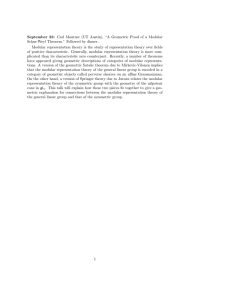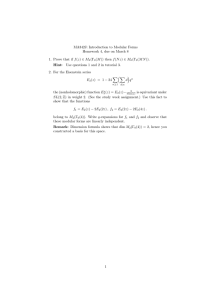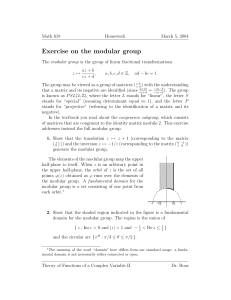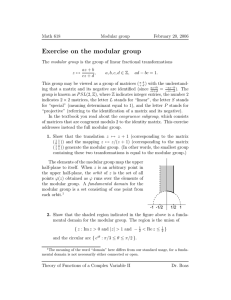Modular Elements of Geometric Lattices
advertisement
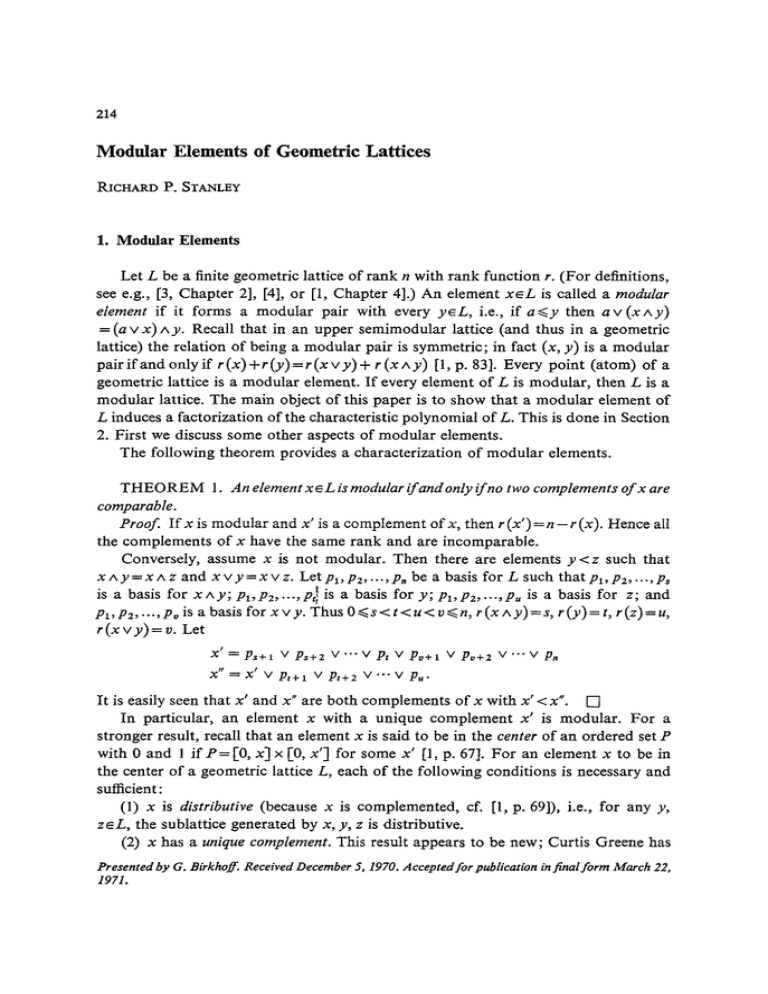
214
Modular Elements of Geometric Lattices
RICHARD P. STANLEY
1. Modular Elements
Let L be a finite geometric lattice of rank n with rank function r. (For definitions,
see e.g., [3, Chapter 2], [4], or [1, Chapter 4].) An element x s L is called a modular
element if it forms a modular pair with every y e L , i.e., if a<~y then a V ( x A y )
= (a v x ) A y . Recall that in an upper semimodular lattice (and thus in a geometric
lattice) the relation of being a modular pair is symmetric; in fact (x, y) is a modular
pair if and only if r (x) + r (y) = r (x v y) + r (x A y) [1, p. 83]. Every point (atom) of a
geometric lattice is a modular element. I f every element of L is modular, then L is a
modular lattice. The main object of this paper is to show that a modular element of
L induces a factorization of the characteristic polynomial of L. This is done in Section
2. First we discuss some other aspects of modular elements.
The following theorem provides a characterization o f modular elements.
T H E O R E M 1. An element x ~ L is modular i f and only if no two complements of x are
comparable.
Proof. I f x is modular and x ' is a complement of x, then r(x') = n - r ( x ) . Hence all
the complements o f x have the same rank and are incomparable.
Conversely, assume x is not modular. Then there are elements y < z such that
X A y = X A Z and x v y = x v z .
L e t p l , p z , . . . , p ~ be a basis for L such that p l , p 2 .... , p ,
is a basis for X A y ; Pl,Pz,...,P~] is a basis for y ; Pl, P2,...,P, is a basis for z; and
p l , p 2 , . . . , p o i s a basis for x v y . ThusO<~s<t<u<v<~n, r ( x A y ) = s , r ( y ) = t , r(z)=u,
r (x v y) = v. Let
x' = Ps+ l v Ps+ 2 v ... v Pt v Pv+l v Pv+2 v .-- v Pn
X" ----X' V Pt+l V Pt+2 V " " V Pu"
It is easily seen that x' and x" are both complements of x with x ' < x". [ ]
In particular, an element x with a unique complement x ' is modular. For a
stronger result, recall that an element x is said to be in the center of an ordered set P
with 0 and 1 if P = [0, x] x [0, x ' ] for some x ' [1, p. 67]. F o r an element x to be in
the center of a geometric lattice L, each of the following conditions is necessary and
sufficient:
(1) x is distributive (because x is complemented, cf. [1, p. 69]), i.e., for any y,
z ~ L , the sublattice generated by x, y, z is distributive.
(2) x has a unique complement. This result appears to be new; Curtis Greene has
Presented by G. Birkhoff. Received December 5, 1970. Acceptedfor publication in final form March 22,
1971.
Modular Elements of Geometric Lattices
215
in fact proved the more general result (unpublished) that the intersection (meet) of
all the complements o f any element of a geometric lattice L is in the center of L.
(3) x is a separator of L [3, Chapter 12], i.e., for any point p and any copoint q not
containing p, either p ~<x or x ~<q.
(4) x is a standard element of L [1, p. 69] (this follows from (2) since a complemented standard element has a unique complement). The concept of standard elements is due to G. Gr/itzer.
2. The Characteristic Polynomial
The characteristic polynomial p f (2) [4] of a geometric lattice L is defined by
p, (2) = Z
yeL
(0, y)
where # denotes the M6bius function of L (see [4]).
This polynomial was first considered by G. D. Birkhoff, while its connection with
M6bius functions was noted by Garrett Birkhoff. IfxmL, the characteristic polynomial
of the segment [0, x] is denoted p , (2).
The main result of this paper is the following factorization theorem:
T H E O R E M 2. l f x is a modular element of a finite geometric lattice L of rank n,
then
TM]
b) 2
The expression in brackets may be thought of as the characteristic polynomial of
the order ideal C ( x ) = { b l x A b = O }. C(x) will have a 1 if and only i f x has a unique
complement x' in L. In this case C (x) = [0, x'] and L = [0, x] x [0, x']. Thus when x
has a unique complement Theorem 2 is trivial, since Pt.l • =PL~PL2.
To prove Theorem 2, we first prove two lemmas. The first lemma is a special case
of some results of Schwan on modular pairs (see [I, Section IV.2]), but for the sake
of completeness we include a proof. It is to be assumed throughout that x is a modular
dement of the finite geometric lattice L, and that L has rank n.
L E M M A 1. For any a~L, the map
[a, a
-, [a ^
defined by c%(y)=x A y is an isomorphism with inverse z ~
y.
Proof. Clearly a, and % are order-preserving. By modularity of x, it is immediate
that if y~[aAX, X], then cr,z,(y)=x A (av y ) = ( x A a ) v y=y. Also if y~[a, a v x],
then % a , ( y ) = a v ( x A y ) = ( a v x ) A y = y , and the p r o o f follows. [ ]
216
Richard P. Stanley
ALGEBRAUNIV.
L E M M A 2. For any y~L, x A y is a modular element of [0, y].
Proof. Let a~ [0, y] and let b ~<a. We need to show b v ((x a y) ^ a) = (b v (x A y)) ^ a.
Using the modularity of x, we have
(by (xAy))Aa=((bvx)Ay)na=(bvx)Aa=bv
=by(x^ (yAa))=bv((xAy)Aa).
(XAa)
[]
Proof of Theorem 2. By Crapo's Complementation T h e o r e m [2], if a e [ 0 , y] then
it (0, y) = ~, It (0, a') ( (a', a") U (a", y),
a', a"
where a' and a" are complements of a in [0, y], and ( is the zeta function of [0, y].
Choosing a = x A y , then by L e m m a 2 all the complements of a have the same rank
and hence are incomparable. Thus
U (0, y) -- Y' U (0, b) It (b, y ) ,
(1)
where the sum is over all complements b of x ^ y in [0, y], i.e., over all b~L satisfying
O<.Nb<~y, b ^ ( x A y ) =0, b v ( x A y ) = y . Now b ^ ( x A y ) = b ^ x , and by the modularity
of x, b v (x ^ y) = (b v x) ^ y. Thus the sum (1) is over all b E L satisfying b ^ x = 0 and
ye[b, b v x]. Hence
pL(;O = Z It (0, y) 2"-'(Y)
y~/.,
2
=E
yeL
It (0, b) It (b, y) )t"-'C')
b^x=O
y~[b, b v x ]
=
2
E
bAx=O ye[b, bvx]
It (0, b)/~ (b, y) ).'-'(')
N o w by L e m m a 1, as y ranges over [b, b v x], z = x A y ranges over the isomorphic
interval [b ^ x, x] = [0, x], and It (b, y) = It (0, z). Moreover r (y) = r (b) + r (z). Therefore
PL (2) = E
E
It (0, a) It (0, z) 2 " - ' ( b ) - ' ' ' '
b^x=O ze[O,x]
3. Examples
As a special case of T h e o r e m 2, suppose x is modular copoint, and that exactly ct
points (atoms) a of L do not lie below x. Then these points a, together with 0, are the
Vol. 1, 1971
Modular Elements of Geometric Lattices
217
only elements b of L satisfying b ^ x = 0. Moreover,/~ (0, a) = - 1,/~ (0, 0) = 1, so
L(2) = px(2)
(- l)+ 2] =
(2-
Thus if L contains a maximal chain O = x o < x l < . . . < x , = l
such that each x~_ x is
modular in [0, x J and such that exactly ~i atoms of ['0, x J do not lie below x i - i , then
Pz (2) = ( 2 - ~i) ( 2 - ~z)... ( 2 - ~,). It is easy to show that the condition that each x i_ 1
is modular in [0, x~] is equivalent to the condition that each x i is modular in L. A
class of geometric lattices with such a 'modular maximal chain' is the following: Let
~1,~2,..., ~, be any collection of positive integers with ~ , = 1 . Let p ~ , . . . , p , be n
independent points, and on the line p~p, (1 ~ i ~<n - 1) insert an additional ~ - 1 points.
The geometric lattice L of flats of this geometry contains a modular maximal chain,
and Pz (2) = ( 2 - ~i) ( 2 - c~2)... ( 2 - c~,).
At this point it is natural to ask for a characterization of the modular elements of
various geometric lattices. We state such a characterization when L is the lattice of
contractions of a finite graph. Recall that a contraction of a graph G may be regarded
as a partition rc of the vertices of G, such that the subgraph H induced by each block
B of n is connected [3, Chapter 6].
T H E O R E M 3. Let L be the lattice of contractions o f a doubly connected finite
graph G. Then reeL is a modular element of L i f and only if the following conditions
hold:
(i) A t most one block B of z~ contains more than one vertex of G.
(ii) Let H be the subgraph induced by the block B of (i). Let K be any connected
component of the subgraph induced by G - B, and let H i be the graph induced by the
set of vertices in H which are connected to some vertex in K. Then H i is a clique (complete
subgraph) o f G. []
The p r o o f is of a routine nature and will be omitted.
If G is not doubly connected, then the lattice of contractions of G is a direct
product of the lattices of contractions of the maximal doubly connected subgraphs of
G, so Theorem 3 easily extends to arbitrary finite graphs G.
REFERENCES
[1] Garrett Birkhoff, Lattice Theory, Third Edition (American Mathematical Society, 1967).
[2] Henry Crapo, The M6bius Function of a Lattice, J. Combinatorial Theory 1 (1966), 126-131.
[3] Henry Crapo, and Gian-Carlo Rota, On the Foundations of Combinatorial Theory: Combinatorial
Geometries, M.I.T. Press.
[4] Gian-Carlo Rota, On the Foundations of Combinatorial Theory, I: Theory of M6bius Functions,
Z. Wahrscheinlichkeitstheorie 2 (1964), 340--368.
M.LT., Cambridge, Mass. U.S.A.
